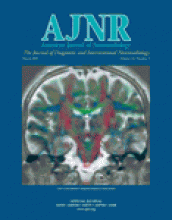Abstract
BACKGROUND AND PURPOSE: The use of 3.0-T MR systems is increasing worldwide. We evaluated magnetic field interactions and translational attraction for 32 aneurysm clips in association with exposure to “long-bore” and “short-bore” 3.0-T MR imaging systems.
METHODS: Thirty-two different aneurysm clips were evaluated in this investigation. Each aneurysm clip was qualitatively evaluated for magnetic field interactions and quantitatively assessed for translational attraction by using the deflection angle test. The deflection angle tests were performed at the points of the highest spatial gradients for long-bore and short-bore 3.0-T MR imaging systems.
RESULTS: Seventeen of the 32 aneurysm clips showed positive magnetic field interactions. Deflection angles for the aneurysm clips were significantly (P < .001) higher on the short-bore (range, 0–18 degrees) compared with those recorded on the long-bore (range, 0–16 degrees) 3.0-T MR imaging system. Aneurysm clips made from commercially pure titanium and titanium alloy displayed no translational attraction (n = 15), whereas those made from stainless steel alloy, Phynox, and Elgiloy displayed positive deflection angles (n = 17).
CONCLUSION: The 32 different aneurysm clips passed (angle <45 degrees) the deflection angle test by using the long- and short-bore 3.0-T MR imaging systems, indicating that they are safe for patients and other persons in these MR environments (ie, immediate area of MR imaging systems). However, only clips made from the titanium and titanium alloy are entirely safe for patients undergoing MR imaging procedures because of the total lack of magnetic field interactions. The remaining clips require characterization of magnetic field-induced torque. Because of possible differences in the points of the highest spatial gradients for different 3.0-T MR imaging systems, the results are specific to the imaging units and bore designs used in this investigation.
- Copyright © American Society of Neuroradiology












